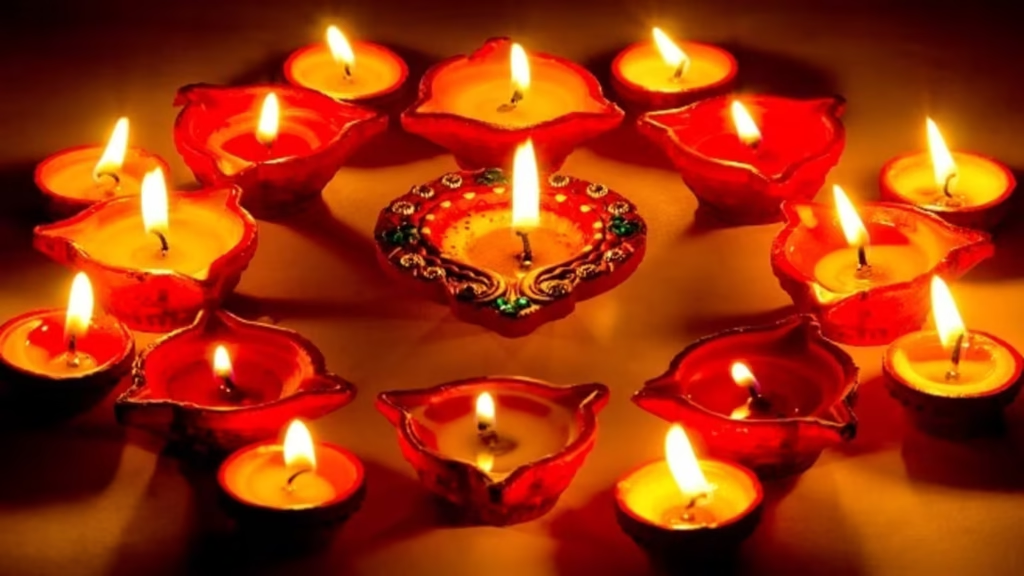Diwali, also known as Deepavali, is one of the most vibrant, joyous, and widely celebrated festivals in India and among Indian communities around the world. Known as the Festival of Lights, Deepavali symbolizes the triumph of good over evil, light over darkness, and knowledge over ignorance. It is a festival that brings families together, lights up every corner of the country, and fills the air with a sense of hope, joy, and celebration.
While the festival is popularly associated with lamps, fireworks, and sweets, its meaning goes far deeper. Deepavaliis not just about rituals; it is about spiritual awakening, cultural unity, and the celebration of life itself. In this blog, let’s explore how Deepavali is celebrated in India, why it holds such importance, and how it has evolved into a global phenomenon.

Table of Contents
1. The Significance of Diwali
The word Deepavali comes from Sanskrit—Deepa meaning “lamp” and Avali meaning “row.” Thus, Deepavali literally means “a row of lamps.” This explains why homes, streets, temples, and businesses are illuminated with oil lamps, candles, and electric lights during this festival.
Different regions of India associate Deepavali with different legends:
- In North India: Deepavali marks the return of Lord Rama, Sita, and Lakshmana to Ayodhya after 14 years of exile and the victory over Ravana. The people of Ayodhya lit rows of lamps to welcome them home.
- In South India: It is celebrated as the victory of Lord Krishna over the demon Narakasura.
- In Western India: Deepavali signifies the worship of Goddess Lakshmi, the goddess of wealth, and marks the start of a new financial year.
- In Jainism: Deepavali commemorates Lord Mahavira’s attainment of nirvana.
- In Sikhism: It marks the release of Guru Hargobind Ji from imprisonment, known as Bandi Chhor Divas.
Despite regional differences, the central theme remains the same—the celebration of victory, prosperity, and renewal.
2. Preparations for Diwali
Deepavali preparations begin weeks in advance, as it is not just a one-day festival but a series of events spread over several days. Families and communities take part in multiple activities:
- Cleaning and decorating homes: A symbolic act of removing negativity and welcoming positivity. Houses are painted, decluttered, and adorned with flowers, rangoli designs, and lights.
- Shopping for clothes and gifts: New clothes are purchased for family members, and gifts are exchanged among relatives and friends.
- Buying sweets and dry fruits: Deepavali is incomplete without traditional sweets like laddoos, barfis, jalebis, and gulab jamuns.
- Puja items and diyas: Families buy clay lamps, candles, and puja essentials to perform rituals dedicated to Goddess Lakshmi and Lord Ganesha.
Markets and bazaars across India come alive with festive colors, lights, and hustle-bustle during this period.
3. The Five Days of Diwali
Although many consider Diwali as a one-day celebration, traditionally it is celebrated for five days, each having its own significance.
Day 1: Dhanteras
The festival begins with Dhanteras, a day dedicated to Lord Dhanvantari, the god of health and Ayurveda. People buy gold, silver, or new utensils, as it is believed to bring good fortune.
Day 2: Choti Diwali (Naraka Chaturdashi)
This day commemorates the victory of Lord Krishna over Narakasura. Homes are decorated with lamps and rangoli, and families prepare for the grand day ahead.
Day 3: Diwali (Main Festival)
The most significant day of the festival is when families perform the Lakshmi Puja. Diyas and candles are lit, prayers are offered to Goddess Lakshmi for wealth and prosperity, and Lord Ganesha for wisdom. Fireworks light up the night sky, and families exchange sweets and gifts.
Day 4: Govardhan Puja / Annakut
On this day, devotees celebrate Lord Krishna lifting the Govardhan Hill to protect villagers from torrential rains. Communities prepare large quantities of food as offerings.
Day 5: Bhai Dooj
The festival ends with Bhai Dooj, which celebrates the bond between brothers and sisters. Sisters pray for their brothers’ long life and prosperity, while brothers give gifts to their sisters.
4. Fire and Light: The Symbolism of Diwali
The essence of Deepavali lies in light and fire. Lamps symbolize the removal of darkness and ignorance, while fireworks signify joy, energy, and the victory of good over evil. Lighting diyas is also believed to invite positive energy and ward off negativity.
In rural areas, traditional clay lamps continue to hold significance, while in urban spaces, electric lights, lanterns, and LED decorations add modern charm.
5. Food and Sweets of Diwali
Deepavali is as much about food as it is about rituals. Families prepare and share a wide variety of delicacies, both savory and sweet. Some festive favorites include:
- Sweets: Laddoos, kaju katli, gulab jamun, rasgulla, and soan papdi.
- Snacks: Mathri, chakli, namak pare, samosas, and kachoris.
- Special drinks: Thandai, lassi, or festive sherbets.
Exchanging homemade sweets is a tradition that strengthens bonds among families and friends.
6. Cultural and Social Celebrations
Beyond religious rituals, Deepavali is also a cultural extravaganza:
- Community gatherings: Housing societies and neighborhoods organize cultural programs, music, dance, and fairs.
- Shopping festivals: Malls, shops, and online platforms offer festive discounts, making it a major shopping season.
- Charity and sharing: Many people also donate clothes, food, and money to the needy during Deepavali, spreading the joy beyond their own families.
7. Fashion and Dressing Up
Deepavali is the time to bring out the best outfits.
- Women: Sarees, lehengas, anarkalis, and Indo-western gowns.
- Men: Kurta-pajamas, sherwanis, or smart casuals.
- Children: Colorful ethnic wear that makes them look festive and joyful.
The festival is also a time when families capture beautiful memories in photographs, often shared on social media.
8. Eco-Friendly Diwali: A Modern Touch
In recent years, there has been a growing awareness about celebrating Deepavali in an eco-friendly way. Excessive use of firecrackers has led to air and noise pollution, and people are finding alternatives:
- Eco-friendly diyas: Clay lamps, candles, and solar lights instead of plastic decorations.
- Limiting fireworks: Many communities encourage minimal or noiseless fireworks to reduce pollution.
- Eco-friendly rangoli: Using natural colors like turmeric, flowers, and rice flour instead of synthetic powders.
This shift ensures that Diwali remains a celebration of light without harming the environment.
9. Diwali Across the World
While Diwali is deeply rooted in Indian culture, it is now celebrated worldwide:
- Nepal: Known as Tihar, the festival includes worship of animals like crows, cows, and dogs.
- Singapore and Malaysia: The festival is celebrated with grandeur, especially in “Little India.”
- United States, Canada, and UK: Indian communities organize Diwali events, cultural performances, and temple gatherings.
- Fiji, Mauritius, and Trinidad: Diwali is a national holiday in these countries with large Indian-origin populations.
This global recognition makes Diwali a festival that transcends boundaries.
10. The Essence of Diwali
At its heart, Diwali is about more than rituals and fireworks. It is about:
- Lighting the inner lamp of wisdom.
- Choosing kindness and generosity.
- Spreading love and joy in communities.
- Strengthening bonds of family and friendship.
- Welcoming a new beginning with hope and positivity.
The light of Diwali reminds us that even in the darkest times, hope and goodness will always prevail.
Conclusion
Diwali, the festival of fire and lights, is more than a celebration—it is a philosophy of life. It teaches us to rise above darkness, embrace positivity, and share joy with others. Whether it is lighting diyas, worshiping Goddess Lakshmi, bursting fireworks, or savoring delicious sweets, every part of Diwali adds to the festive charm.
In today’s fast-paced world, festivals like Diwali remind us to pause, reconnect with our roots, and cherish the bonds that truly matter. No matter where you are in the world, celebrating Diwali fills your heart with warmth, gratitude, and happiness.
As millions of lamps shine together, Diwali reminds us that light is the ultimate symbol of life, and it is our duty to spread that light to every corner of the world.
